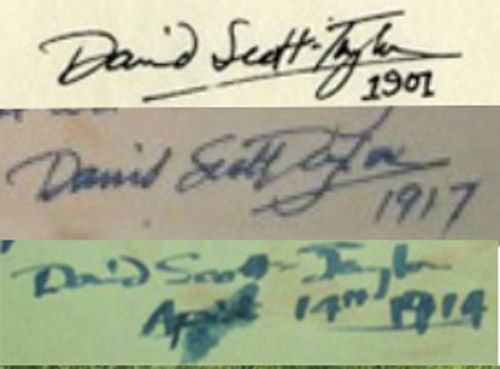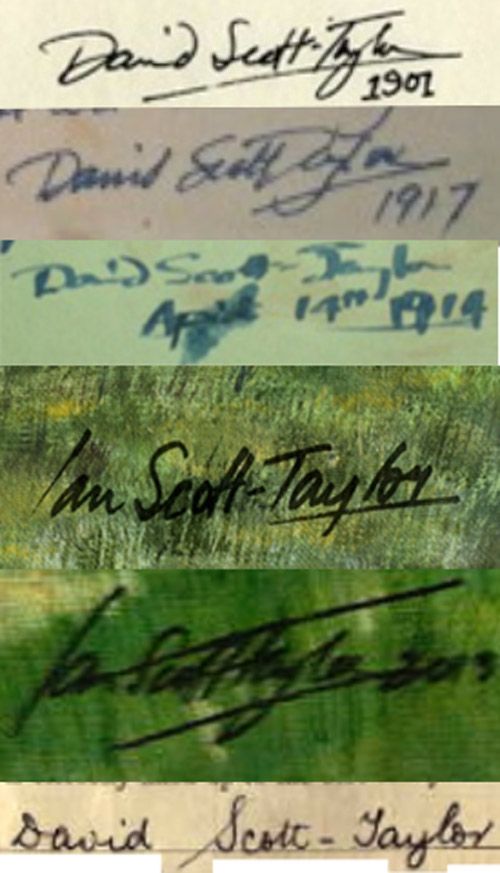Another reservation I have about the "report" concerns the supposed control samples used for the "David Scott-Taylor" signature analysis. In the case of the other three parties, it seems that control samples would have been available. For example, for Tillinghast's signature, Phil indicated that the report said:
"'Copies of the signature where obtained from the United States and Collectors offered by the [major Scottish Institution].'"But what is the source of the control samples for David Scott-Taylor's signature? The quotes from the report don't say, but Phil and Neil have indicated that some of these came from the alleged David Scott-Taylor's diaries! Given that the authenticity of both the drawings and the diaries are at issue, signatures from the diaries cannot be used to authenticate the signature on the drawing! In short, even if they match, they both could be fake. Any experts would know this, unless they were not told that the authenticity of the diaries was at issue as well.
Phil and Neil also mentioned that a signature from David Scott-Taylor's Will was used. Adam Lawrence asked if Phil would post it, but he has not, so it is impossible to fully consider. (I'd like to know more about this will, as I don't recall it being mentioned in these discussions until this round.) If the Will was obtained from the National Registry, then it indeed may be a valuable control sample. But if it is another document from underneath "Mum's bed," then we have the same control problem as with the signatures from the diary. I've searched the National Probate Registry Index for David Scott-Taylor's will, and it is not there.
So what are we left with? So far, the signature from the ironically named "Score's Hotel" painting and signatures from the diary. I've seen two of the latter thus far. The top is from the "Score's" painting the other two are from the diaries.

Unlike some here, I won't pretend to be an expert on signatures or handwriting, but from this layman's perspective there are some interesting similarities, and interesting differences as well. The number formations varies greatly, as do certain aspects of the signatures. And the last signature doesn't really look much like the first two, even though it was supposedly between the two in time.
It becomes even more interesting when we add a few more signatures.

The next two are Ian Scott-Taylor's signatures from his artwork. It sure looks like aspects of his signature fit pretty well with the signatures that are being scrutinized. The "Scott-Taylor" in the last of the DST signatures looks an awful lot like the "Taylor" in the first of the IST signatures, only with a different tilt, and there are plenty of other similarities as well.
The last signature is from the 1911 census form of "David Scott-Taylor." At this point,
it is only signature we have from a separate, independent source. And the only one that didn't come from Ian Scott Taylor.
Neil claims we need to dismiss this last signature, but to reach his conclusion he turns the authentication process on its head. He proposes we throw out the independent control sample because it doesn't match the group of signatures being scrutinized. Of course that is not how these things go. If the signatures being scrutinized don't match the control, then the authentication fails.
Neil and Phil also argue that the last signature might either be 1) a different Ian Scott Taylor, or 2) his wife signing for him. I am willing to consider both possibilities.
1) The easiest way to address the first issue is to compare the information on the rest of the form to the information from the diary. As soon as Ian and Phil are ready to divulge the information about DST's family, we can make this comparison.
2) The second is trickier, but no need to even address it until we have resolved the first.
It would really advance the conversation if Phil and Ian would come forward with the names of David Scott-Taylor's first wife and children, and his hometown (after he came back from India.) I am starting to wonder if they even know this information . . .